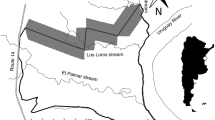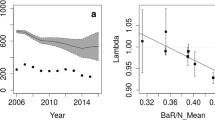Abstract
We assessed dung and track counts for indexing brocket deer abundance in seasonal habitats on a ranch where hunting is not practiced in the Bolivian lowlands. Surveys were replicated along four 10-km trails (totaling 180 km in the wet season and 90 km in the dry season) through four semideciduous forest habitats. Dung pellets and tracks were identified as belonging to Mazama gouazoubira or M. americana by size and shape. Pellet groups lasted more than 1 month during the dry season, but decayed within 1–2 weeks in the wet season. Mean density estimates based on dung counts varied widely between seasons for gray brockets (from 6.77±4.0 to 30.57±23.5 ind/km2; mean±SD) but not for reds (from 3.52±4.6 to 6.98±7.2 ind/km2). These values were probably too high due to underestimation of daily deposition rate, and were reduced during the wet season because of dung decay. We found consistently more dung in the dry season and more tracks in the wet season. Sightings of red brockets were too few for line-transect analysis (n=6), but those of gray brockets (n=42) produced an overall estimate of 5.6 ind/km2 (95% CI=3.5–9.0 ind/km2). Different estimates indicated that gray brockets were more abundant than reds in all situations, except perhaps in the riverine forest. Environmental factors affected these indices of abundance differently, and while we recommend the use of dung counts in dry-season scenarios, we think that index reliability should be assessed locally before conducting population comparisons.


Similar content being viewed by others
References
Ayala J, Noss A (1999) Censos por transectas en el chaco boliviano: limitaciones biológicas y sociales de la metodología. In: Estudios de investigación y manejo de fauna enel Izozog y Parque Nacional Kaa Iya. CABI-WCS, Santa Cruz, pp 72–85
Barnes RFW, Barnes KL (1992) Estimating decay rates of elephant dung piles in forest. Afr J Ecol 30:316–321
Bodmer RE (1997) Ecologia e conservacao dos veados mateiro e catingueiro na Amazonia. In: Duarte JM (ed) Biologia e conservaçao de Cervideos Sul Americanos: Blastoceros, Ozotoceros e Mazama. FUNEP, Jaboticabal, pp 70–77
Buckland ST, Anderson DR, Burnham KP, Laake JL (1993) Distance sampling: estimating abundance of biological populations. Chapman Hall, London
Conroy MJ (1996) Abundance indices. In: Wilson DE, Cole FR, Nichols JD, Rudran R, Foster M (eds) Measuring and monitoring biological diversity: standard methods for mammals. Smithsonian Institution Press, Washington, pp 179–192
Cuellar E (1997) Evaluación de una comunidad de mamíferos medianos y grandes en una zona de bosque semideciduo Chiquitano empleado como método principal el estudio y clasificación de huellas. Licenciatura Thesis, UAGRM, Santa Cruz
Emmons LH, Feer F (1997) Neotropical rainforest mammals: a field guide, 2nd edn. University of Chicago Press, Chicago
Fuentes A, Navarro G (2000) Estudio fitosociológico de la vegetación de una zona de contacto Chaco-Cerrado en Santa Cruz (Bolivia). Lazaroa 21:73–109
Guinart D (1997) Los mamíferos del bosque semideciduo neotropical de Lomerío (Bolivia): interacción indígena. PhD Thesis, Universidad de Barcelona, Barcelona
Hill K, Padwe J (2000) Sustainability of Aché hunting in the Mbaracayu Reserve, Paraguay. In: Robinson JR, Bennett EL (eds) Hunting for sustainability in tropical forests. Columbia University Press, New York, pp 79–105
Hurtado-Gonzales JL, Bodmer RE (2004) Assessing the sustainability of brocket deer hunting in the Tamshiyacu-Tahuayo Communal Reserve, northeastern Peru. Biol Conserv 116:1–7
Maffei L, Taber AB (2003) Area de accion de Mazama americana (Cervidae) en un bosque seco de Bolivia. Ecol Bolivia 38:179–180
Noss AJ, Cuéllar E, Cuéllar RS (2003) Hunter self-monitoring as a basis for biological research: data from the Bolivian Chaco. J Neotrop Mamm 10:49–67
Ojasti J (1993) Utilización de la fauna silvestre en América Latina: situación y perspectivas para un manejo sostenible. Guía FAO Conserv 25:1–248
Peres CA (2000) Evaluating the impact and sustainability of subsistence hunting at multiple Amazonian forest sites. In: Robinson JG, Bennett EL (eds) Hunting for sustainability in tropical forests. Columbia University Press, New York, pp 31–56
Pinder L, Leeuwenberg F (1997) Veado catingueiro (Mazama gouazoubira, Fisher 1814). In: Duarte JM (ed) Biologia e conservaçao de Cervideos Sul Americanos: Blastoceros, Ozotoceros e Mazama. FUNEP, Jaboticabal, pp 60–68
Rabinowitz A (1993) Wildlife field research and conservation training manual. Wildlife Conservation Society, New York
Rivero K (1997) Densidad poblacional y uso de hábitat de Mazama gouazoubira y Mazama americana en la estancia San Miguelito, provincia Ñuflo de Chavez, Santa Cruz, Bolivia. Licenciatura Thesis, UAGRM, Santa Cruz
Rivero K, Rumiz DI, Taber AB (2005) Differential habitat use by two sympatric brocket deer species (Mazama americana and M. gouazoubira) in a seasonal Chiquitano forest of Bolivia. Mammalia (in press)
Rumiz DI, Guinart S, Solar L, Herrera JC (2001) Logging and hunting in community forests and logging concessions: two contrasting case studies in Bolivia. In: Fimbel RA, Grajal A, Robinson JG (eds) The cutting edge, conserving wildlife in logged tropical forests. Columbia Unversity Press, New York, pp 333–358
Schaller G (1983) Mammals and their biomass on a Brazilian ranch. Arqui Zool 31:1–36
SYSTAT (1997) Systat 7.0 for Windows: statistics. SPSS, Chicago
Townsend W (1996) Nyao ito: caza y pesca de los siriono. Instituto de Ecologia, UMSA Fund-Eco, La Paz
Walker RS, Novaro AJ, Nichols JD (2000) Consideraciones para la estimación de abundancia de poblaciones de mamíferos. J Neotrop Mamm 7:73–80
Acknowledgements
We thank Ronald Larsen, the owner of the ranch, and Negro Mejía, don Adolfo and doña Dirma Pizarro for their invaluable support in the field. Fellow biologists Alfredo Fuentes, Jose Luis Santivañez, Erika Cuéllar, and Leo Maffei also made this study possible with their help and companionship at La Pascana. We are grateful to E. Cuéllar for allowing us to use her track-plot data and to Humberto Gomez for helping with the distance analysis. Louise Emmons, Rob Wallace, Andy Noss, Luis Pacheco, and two anonymous reviewers provided useful comments on the manuscript. The study was funded by the Wildlife Conservation Society through an agreement with the Museo Noel Kempff Mercado, UAGRM. The Santa Cruz Zoo kindly gave us access to their captive deer. This research complies with the current laws of Bolivia.
Author information
Authors and Affiliations
Corresponding author
Rights and permissions
About this article
Cite this article
Rivero, K., Rumiz, D.I. & Taber, A.B. Estimating brocket deer (Mazama gouazoubira and M. americana) abundance by dung pellet counts and other indices in seasonal Chiquitano forest habitats of Santa Cruz, Bolivia. Eur J Wildl Res 50, 161–167 (2004). https://doi.org/10.1007/s10344-004-0064-x
Received:
Accepted:
Published:
Issue Date:
DOI: https://doi.org/10.1007/s10344-004-0064-x




